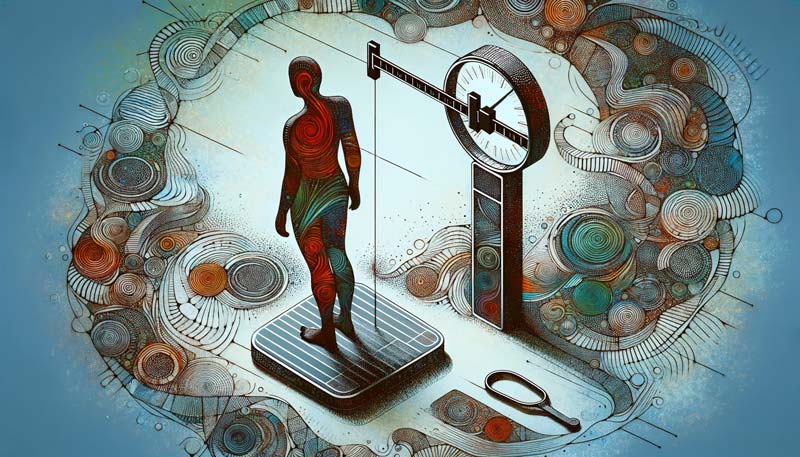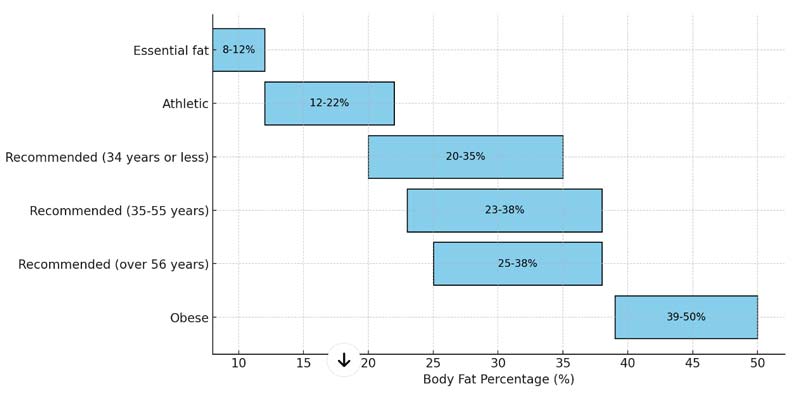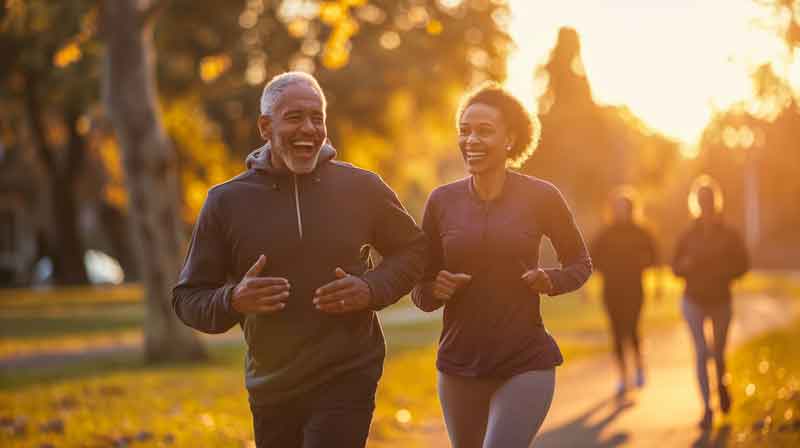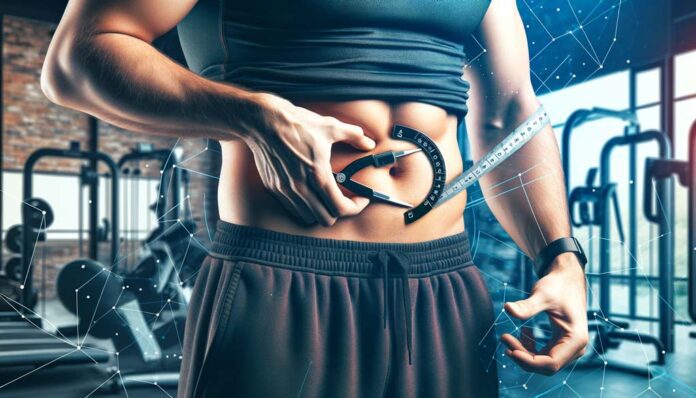Understanding BMI and body fat percentage is crucial for gauging health accurately, offering insights that go beyond mere weight figures. My experiences were marked by misunderstandings and wrong assessments. They spurred me to write this post. I was highly active and competed in sprinting at a national level. But, my Body Mass Index (BMI) consistently suggested I was overweight. It was a clear misrepresentation of my health.
The main problem with BMI is its lack of nuance, failing to differentiate between muscle and fat. This oversight became a significant point of frustration for me as an athlete, where muscle density plays a crucial role but is misleadingly flagged by BMI.
Through my lens, we will look at the flaws of BMI. We will also see the value of body fat percentage for a true picture of health. Unlike BMI, body fat percentage provided a truer reflection of my condition, highlighting the lean physique masked by the generalised view of BMI.
This post will guide you through the basics of BMI and body fat percentage. It will stress their importance. It will also stress their limits and the need for more complete health assessments.
We will discuss their relevance to athletes, the precision of various measurement methods, and why relying solely on BMI can be deceptive. My transition from battling BMI’s inaccuracies to championing a detailed approach to body composition aims to shed light on the necessity for broader health evaluations.
As we progress, expect an enlightening perspective on these health metrics, informed by personal encounters and a scientific foundation. This post’s core aim is to inform and equip you. It will help you make better health choices.
This is a call to action. It calls for a better way to understand BMI and body fat percentage. It advocates for health assessments that truly reflect individual physical health.
My Journey with Understanding BMI and Body Fat Percentage
Struggling with BMI and body fat has shaped my understanding of health metrics. Despite being an athlete, my BMI often hovered around 24% to 25%, suggesting I was overweight for my height of 5’8″. This was in stark contrast to my body fat percentage, which has been consistently around 8% since I was 21, indicative of high fitness levels, not excess weight. The discrepancies were glaring. This is especially true given my VO2 max is 65% – exceptional for a sprinter.
The reliance on BMI ignored the fact that muscle weighs more than fat. This oversight became particularly evident in my transition from football to sprinting. Regardless of my physical condition or my performance metrics, understanding BMI and body fat percentage failed to provide an accurate health assessment.
The same issue arose with my son. His growth did not fit the usual BMI charts. From an early age, he was growing very fast, above the 104th percentile. But, concerns about his weight arose, ignoring his exceptional height growth. Understanding BMI and body fat percentage in this context highlighted the limitations of standard health metrics.
These experiences have led me to advocate for a broader set of health metrics. Waist circumference, hip circumference, and waist-to-hip ratio, alongside body fat percentage, offer a more nuanced understanding of health. The figures are on my platform. They show the importance of personalized health assessments. These go beyond BMI to embrace a fuller picture of health.

What is Body Mass Index (BMI)
BMI is known for its role in evaluating the impact of body weight on health. It highlights risks for diseases like heart disease and diabetes. As BMI escalates, so does the likelihood of developing these and other weight-related conditions, including stroke and some cancers.
BMI’s essence lies in its calculation. It compares weight to height. This is achieved through the formula: BMI = Body Mass (kg) / Height (m)². For those using feet and pounds, the calculation is (Weight x 703) / (Height²).
Despite its simplicity, BMI gives a broad evaluation of weight. But, it’s important to note its generality. This is especially true for people like elite bodybuilders. Their high muscle mass may cause a misleading classification as obese.
BMI categorises weight status into several distinct ranges, serving as a quick reference to understand one’s health about body weight:
- Underweight: Less than 18.5
- Normal weight: 18.5 to 24.9
- Overweight: 25 to 29.9
- Obesity: 30 or higher
These categories facilitate the basis of understanding BMI and body fat percentage can be integral to assessing health, emphasising the importance of using multiple metrics for a comprehensive health evaluation.
The Purpose of BMI: A Quick Health Assessment Tool
BMI offers a simple way to classify people by weight. It helps find health risks early. It’s particularly helpful for quickly identifying those who might be at an increased risk for conditions related to their weight class, such as metabolic diseases.
The process of categorising weight through BMI highlights its utility in health screenings. It provides a fast way to assess where individuals fall on the weight spectrum. It prompts more investigation into health markers. This is for those found at either end of the scale. BMI focuses on quick assessment. It is crucial for health evaluations. BMI signals when more detailed analysis might be needed.
The Limitations of BMI: Why It Falls Short
BMI has a key limit. It can’t tell fat and muscle apart. Research indicates a significant portion of individuals with a normal BMI might possess a high body fat percentage, a condition termed as ‘normal weight obesity’. They face similar health risks to those with a higher BMI. This challenges the idea that a normal BMI means health.
For active individuals or athletes, BMI may not be a true reflection of health and fitness. Athletes often carry more muscle weight, potentially classifying them as overweight or obese by BMI standards, despite being in excellent physical condition. This discrepancy shows the need for a more nuanced health assessment. It should consider muscle mass, not just body fat.
Understanding BMI and body fat percentage requires adding more measures. This gives a full view of health. By moving beyond BMI’s focus, we can get a more accurate view of a person’s health. It will make sure we consider factors like muscle.
The Misconceptions Surrounding BMI
A common misconception about BMI is its origin; many believe it was developed by health organisations like the NHS (National Health Service) or the CDC (Centres for Disease Control and Prevention) as a straightforward tool for assessing health.
However, BMI’s modern application was significantly influenced by Ancel Keys in the 1970s. Observing the rise of obesity, Keys conducted extensive research to devise a quick method for evaluating body composition and disease risk. Primarily for population studies rather than individual diagnosis.
Keys envisioned BMI as a way to gauge health risks across populations. It offers a basic estimate of body fatness at a large scale. Despite this goal. BMI’s ease of use led to its widespread use in clinics. It was sometimes the only metric for assessing health.
This simplification overlooks BMI’s limits. It misses the need for full health evaluations. These contribute to the misconception that BMI alone can determine health, without considering other vital factors.

Understanding Body Fat Percentage
Understanding body fat percentage offers a nuanced approach to assessing health and fitness, enhancing our grasp of how body composition affects overall well-being.
BMI estimates body composition broadly. But, body fat percentage accurately separates fat from muscle. It gives a clearer insight into an individual’s health. This distinction is crucial for understanding BMI and body fat percentage, making body fat a valuable tool for evaluating risks associated with weight-related diseases.
Body fat percentage precisely quantifies the fat portion of your body. If someone weighs 90 kg with 18kg of fat, their body fat percentage is 20%. This measurement is vital as it reflects not just weight but its composition, distinguishing fat from lean mass such as muscle, bones, and organs. Such difference is key to understanding BMI and body fat percentage. It offers a more exact view of health and fitness.
Body fat percentage varies across individuals. It is influenced by activity levels and fitness. This shows how lifestyle affects body composition. Athletes, for example, tend to have lower body fat due to rigorous training. Safe body fat percentages, as low as 10% for women and 3% for men as per the American College of Sports Medicine (ACSM), illustrate the impact of physical activity.
Calculating body fat percentage involves measuring fat mass compared to body weight. This gives insights beyond mere weight metrics. Tools like body composition scales facilitate this, offering a detailed view of health that aids in understanding BMI and body fat percentage more comprehensively.
Furthermore, a healthy body fat percentage is crucial for well-being. High body fat is linked to many health challenges. These include heart disease, high blood pressure, and diabetes.
The Role of Body Fat in Overall Health
Body fat plays a multifaceted role in our overall health, acting as more than just a reserve of calories. Distinguishing the two main types of body fat is essential. They are subcutaneous and visceral.
Subcutaneous fat, the layer we can pinch, is found just beneath the skin, often around the hips. Visceral fat, however, resides deeper, surrounding our organs. This type of fat is metabolically active, influencing hormone production that regulates appetite, body weight, and feelings of fullness. Too much visceral fat is linked to big health risks. These include insulin resistance and fatty liver disease.
Moreover, body fat serves crucial protective and regulatory functions. These vitamins, such as A, D, E, and K, are fat-soluble. They need enough body fat for absorption. Therefore, maintaining adequate body fat levels is vital for nutrient uptake and overall nutritional health.
Understanding BMI and body fat percentage is vital. The CDC notes that high body fat, especially obesity, raises the risk of chronic conditions that cause early death. Yet, it’s crucial to maintain a balance, as too little body fat can adversely affect health.
Body fat is integral to glucose regulation, cholesterol management, energy storage and release, and the metabolism of reproductive hormones. Insufficient body fat can disrupt these critical bodily functions.

Healthy Body Fat Percentage Ranges for Men and Women
A key part of understanding BMI and body fat percentage is knowing healthy body fat ranges. These ranges vary by sex due to biological differences. The ACSM provides guidelines that define these variations clearly. For women, the scale of body fat percentages ranges from as low as 10%, indicative of essential fat necessary for bodily functions, to beyond 31%, which may signal an unhealthy level of body fat. See the chart above for a detailed breakdown of these percentages.
Men require less body fat, with essential fat percentages starting as low as 3%. The athletic range is significantly leaner for men, reflecting the lower body fat needed for optimal male physiological function. Men’s body fat percentages that indicate obesity start over 25%. They highlight the higher health risks of more body fat. For a comprehensive view of these percentages, see the chart below.

Both charts are crucial tools. They aid in assessing a person’s fitness and health. They also show that it’s important to keep body fat within recommended levels. This cuts the risk of health issues tied to both high and low body fat.
Athletes and Understanding BMI and Body Fat Percentage
In athletes, understanding BMI and body fat percentage requires a refined approach. Athletes often have low body fat percentages. These percentages reflect the demands of their sports. Males typically between 6-13% and females around 14-20%. This variance shows the limits of using BMI alone. It is the measure of health and fitness for those in competitive sports.
The term “skinny fat” is used to describe the phenomenon where individuals might have a normal weight yet a higher body fat percentage, a condition that can obscure the true state of one’s health.
Athletes must keep body fat in the athletic range. This is key for performance and looks. It shows the importance of a balanced diet and full exercise plan over just targeted workouts.
Understanding BMI and body fat percentage should be included in athlete assessments. This change will give a more accurate view of their physical health. It moves past simple metrics to embrace the complexities of body composition.
Measuring Body Fat Percentage
The challenge of accurately determining body fat percentage lies in the variance and accessibility of measurement methods. Some methods are used more at home and in gyms. These include skinfold measurements and bioelectrical impedance analysis.
However, they can be inaccurate. They have error rates as high as 8%. On the other hand, techniques like dual-energy X-ray absorptiometry (DEXA) scans and hydrostatic weighing offer higher accuracy but are less accessible due to their cost and the need for specialised equipment.
To understand BMI and body fat percentage, it’s essential to know the different techniques.
- Skinfold Callipers
- Bioelectrical Impedance Analysis (BIA)
- Hydrostatic Weighing
- DEXA Scans
Each method has its own advantages and limitations. These will be explored in detail in the following sections.

Skinfold Callipers: An Accessible Method
Skinfold callipers present an accessible and cost-effective option for individuals keen on measuring their body fat percentage. This method is hailed for its accuracy among average gym-goers. But, using it well requires skill.
Utilising callipers involves measuring fat thickness at multiple body sites. This necessity stems from the varied fat distribution patterns among individuals, necessitating a holistic approach to achieve accurate body fat estimations.
For instance, a difference in fat storage areas could skew results. This could happen if the fat is mostly on the thighs. This would affect measurements if they are isolated. So, a full assessment should include many points. For men, these are the chest, abdomen, and thigh. For women, these are the triceps, suprailia, and thigh.
This method shows the need for skilled execution. It minimises human error and ensures a reliable gauge of physical health. It helps in the quest for understanding BMI and body fat percentage.
Bioelectrical Impedance Analysis: Pros and Cons
Bioelectrical Impedance Analysis (BIA) stands out as a popular method for estimating body fat percentage, largely due to its simplicity and affordability. BIA is found in various forms, from home scales to handheld devices. Its appeal is clear in the quest to understand BMI and body fat percentage.
The idea behind BIA is to send a small electric current through the body using two conductors. This current navigates through different tissues, with fat and muscle affecting its conductivity in distinct ways. The resulting data, captured by the second conductor, offers an insight into the body’s composition.
People widely trust electronic accuracy. However, BIA devices struggle to give precise results. We need different equations for specific ethnicities and genders. But, the reliance on manufacturers to select the right formula makes errors likely.
Revealing experiments and Consumer Reports highlight this issue. Six BIA scales were compared to the Bod Pod, a highly accurate lab device for body composition. The most accurate BIA scale was still off by 21% from the Bod Pod. The least accurate was off by 34%. This difference shows the limits of relying only on BIA. It can’t accurately analyse body composition.
BIA devices offer a handy way to measure body fat at home. But, it’s key to approach buying and using them with a critical eye. Thorough research before acquisition can cut the risk of misleading outcomes. It guards against potential setbacks on one’s health drive.
Hydrostatic Weighing and DEXA Scans: The Most Accurate Methods
Hydrostatic weighing and DEXA scans are the most accurate methods. They measure body fat percentage. They beat other techniques in precision. While callipers and BIA are convenient. They cannot match the accuracy of these advanced methods. They require specialised equipment typically found in laboratories.
- Hydrostatic Underwater Weighing: Utilises water displacement to accurately determine body composition. This method calculates body density. It measures the volume of water displaced during submersion. It provides a highly precise measure of body fat.
- A DEXA Scan: Employs dual X-ray absorptiometry. It scans the body with two X-ray beams at different energy levels. This allows for a detailed assessment of body composition. It includes fat, muscle, and bone density. DEXA scans are renowned for their accuracy and are increasingly available. This makes them a good option. It’s for those seeking detailed insights into their body.
Given their unparalleled accuracy, these methods are ideal for anyone requiring a detailed analysis of their body fat percentage. However, the cost and access to hydrostatic weighing and DEXA scans may limit their use. For those who want to understand BMI and body fat percentage, they are the best options.

Typical Body Fat Percentages for Athletes
Athletes’ body compositions are finely tuned to the demands of their sport. Understanding BMI and body fat percentage is crucial to improving performance. The chart above shows body fat ranges by sport and gender. It gives a vivid snapshot of the diversity in athletics.
Bodybuilders, for example, often strive for extremely low body fat levels, typically between 5-8% for males, to showcase muscle definition. In contrast, female basketball players have a body fat percentage of 20-27%. This supports their need for agility and endurance. These variations underscore the inadequacy of a singular approach to fitness and health.
Gravitational sports athletes, such as runners and cyclists, usually have lower body fat percentages to minimise energy expenditure against gravity. Aesthetically judged sports, like gymnastics, require athletes to balance muscle and flexibility. This results in specific body fat ranges. These ranges differ greatly from those in other sports.
As my life shows, despite a high BMI, keeping a body fat percentage of around 8% indicates high fitness, not excess weight. Even at 46 years of age, my body fat is 8-10%. My health and fitness are better shown by body fat than by BMI.
Before I started weight training at 21 years of age, I weighed 69kg. After I began, my weight went up to around 72kg. But, my body fat percentage stayed low. This experience highlights the contrast between BMI and body fat percentage. It shows the importance of using the right measures for athletes and active people.
My experience and the chart offer relatable and backed understanding. They explain the key details in athlete health assessments. It calls to look beyond basic health metrics. Instead, it favours a more personalised approach. This approach factors in the unique needs of each sport and athlete.
BMI vs. Body Fat Percentage: Insights into Understanding BMI and Body Fat Percentage
When it comes to understanding BMI and body fat percentage, the debate on which metric to use can be complex. Both offer insights into health but from different perspectives.
1) Cost and Accessibility:
Calculating BMI is cost-efficient. It’s nearly free and easy. You just need your height and weight. Skinfold callipers are cheap. But, they need an expert’s touch for accuracy. This incurs extra costs.
2) Time Investment:
Both BMI and bioelectrical impedance analysis (BIA) share quick turnaround times for results. In contrast, calliper measurements are detailed but take more time. They can’t be done alone. This adds to the hassle of scheduling and travel.
3) Effectiveness in Health Assessment:
BMI is useful for initial screening. It was not meant to be the only measure of health. In medical contexts, it serves as a preliminary gauge — a higher BMI can signal a need for further analysis. However, understanding BMI and body fat percentage as separate entities is key. Body fat percentage offers specific insights into body composition. But, it can mislead in extreme conditions.
The Importance of a Multi-faceted Approach:
Relying on body fat percentage furnishes a clearer picture of where you stand. Yet, BMI isn’t inherently flawed; its misuse has clouded its effectiveness. It’s not the best tool for individuals. This is especially true for athletes who need detailed body composition analysis. Looking beyond BMI and body fat percentage. Adding more health measures can boost accuracy.
- Waist Measurement as a Health Indicator: For men, a waist under 36 inches is linked to lower health risks. For women, the target is a waist size of less than 35 inches. The measurements align with the guidelines. They aim to reduce the risk of health issues from excess belly fat. It’s a simple gauge. It’s effective. It can be used with BMI and body fat percentage for a full health assessment. Remember, each person is different. These figures are starting points for broader conversations about health and fitness.
- Mirror Test: Sometimes the simplest method can be effective. Self-assessment in the mirror should be honest, balancing satisfaction with health goals.
- Physical Well-being: Assess how you feel. If a lower body fat percentage compromises your well-being, it might be worth maintaining a slightly higher percentage that supports optimal energy and mood.
Understanding BMI and body fat percentage highlights that health isn’t just a number. It’s about the full picture. The picture combines health indicators with satisfaction and performance.

Final Remarks on Understanding BMI and Body Fat Percentage
Reflecting on my journey, the lessons I learned show the limits of BMI. This is especially true for athletes. Meeting a medical professional who understood that BMI is irrelevant for athletes was key. This moment reinforced the need for a health assessment approach. The approach must account for a broader range of measures.
Understanding BMI and body fat percentage has shown me the importance of a nuanced view. Body fat percentage shows the amount of muscle and fat. It gives a more accurate picture of health than BMI alone. This understanding is crucial. It’s especially so for those of us with lots of muscle. BMI may call us overweight or obese when we’re not.
Measuring body fat has challenges. These include the skills needed for using callipers. Also, the limited access to advanced methods, like CT scans. They show the need for better tools and education for health professionals. BMI’s simplicity made it popular. But, it falls short for athletes and some groups.
The misapplication of BMI with my son further illustrates the flaws in how health data is often used. His growth was above the 104th percentile. It showed the need to consider individual growth, not just standard charts. These experiences reinforce that a holistic view of health data is key. It must consider each person’s unique circumstances.
Through this post, I invite you to embrace a broader approach to health assessments. It includes understanding BMI and body fat percentage. But, it also includes other key measures. These measures truly reflect one’s health and fitness.
Sources
- Ackland T, Lohman T, Sundgot-Borgen J, Maughan R, Meyer N, Stewart A, Wolfram M. “Current Assessment of Body Composition in Sport.” Sports Med. 2012; 42(3): 227-249.
- American College of Sports Medicine. ACSM’s Resource Manual for Exercise Testing and Prescription. 11th Edition. Philadelphia [PA]: Wolters Kluwer; 2014.
- American Academy of Paediatrics’ Committee on Sports Medicine and Fitness. Promotion of healthy weight-control practices in young athletes. Pediatrics. 2005;116(6):1557-1564.
- Asker Jeukendrup and Michael Gleeson. 2009. “Sport Nutrition: an Introduction to Energy Production and Performance”. Second Edition. Human Kinetics.
- Coppini LZ, Waitzberg DL, Campos AC. Limitations and validation of bioelectrical impedance analysis in morbidly obese patients. Curr Opin Clin Nutr Metab Care. 2005 May;8(3):329-32.
- Sardinha LB, Going SB, Teixeira PJ, Lohman TG. Receiver operating characteristic analysis of body mass index, triceps skinfold thickness, and arm girth for obesity screening in children and adolescents. Am J Clin Nutr. 1999;70(6):1090-1095.
- Wellens RI, Roche AF, Khamis HJ, Jackson AS, Pollock ML, Siervogel RM. Relationships between the body mass index and body composition. Obes Res 1996;4:35–44.
- Whitlock EP, Williams SB, Gold R, Smith PR, Shipman SA. Screening and interventions for childhood overweight: a summary of evidence for the US Preventive Services Task Force. Pediatrics. 2005;116(1):125-144



